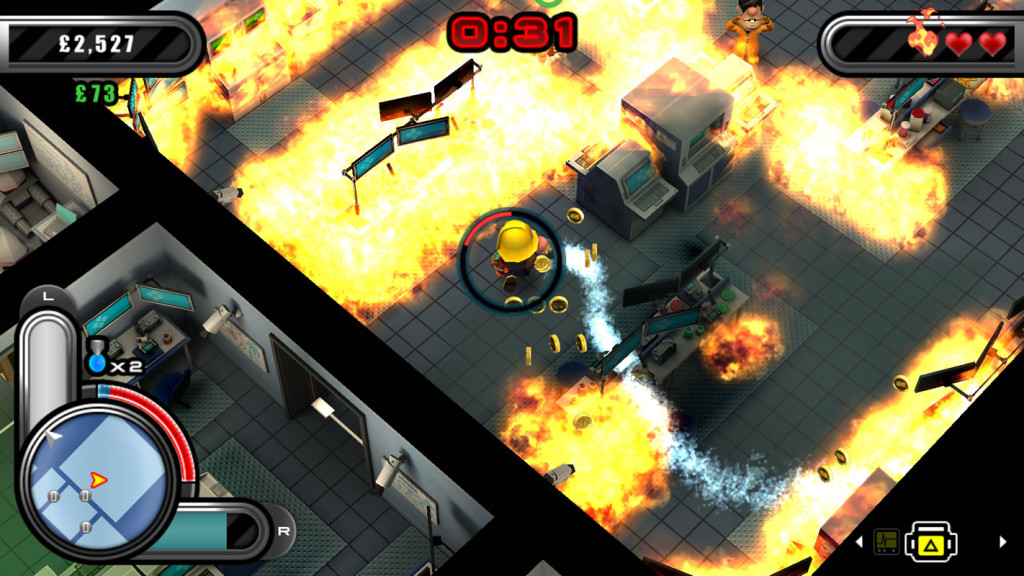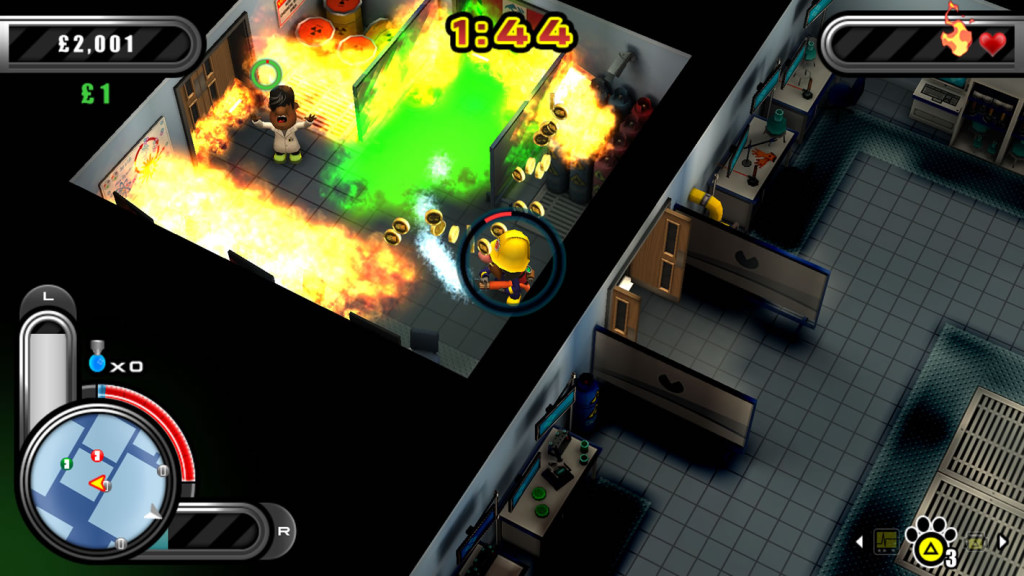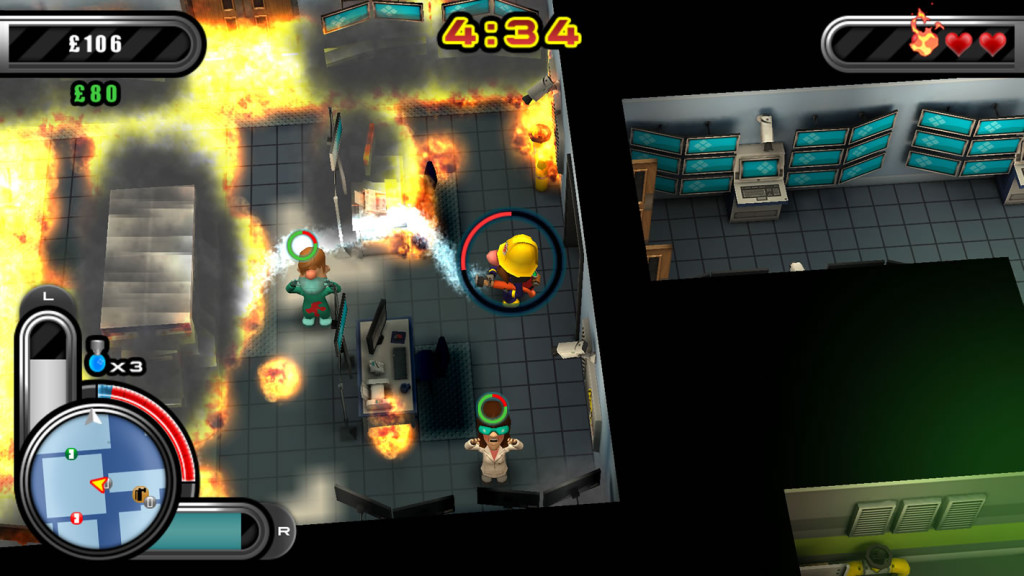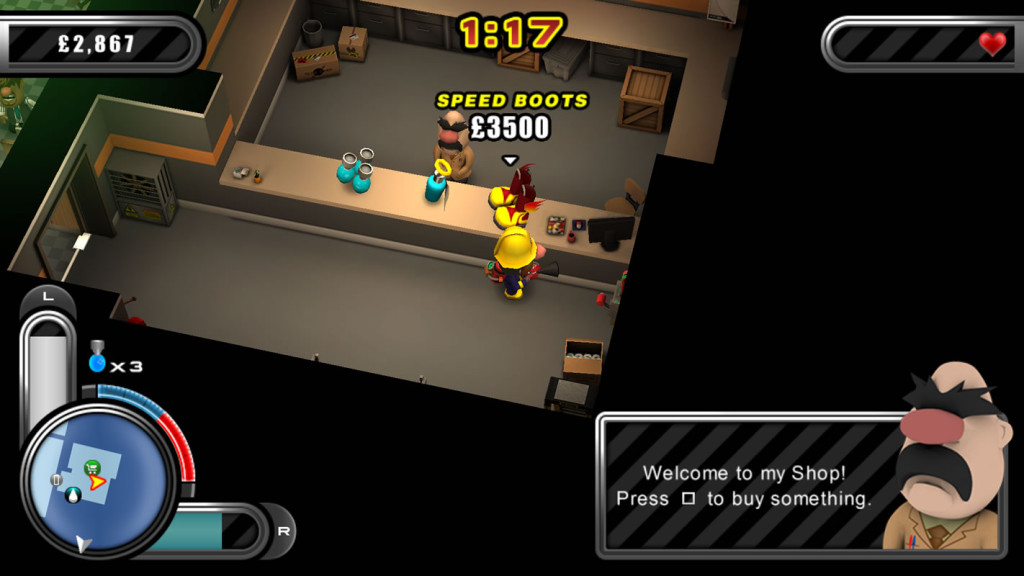
With the rise of mobile and handheld gaming encouraging novel, bite-sized experiences that are still capable of taking creative risks, roguelikes have seen a return to prominence in recent years. Their structure allows for different experiences, with sessions not intended to last more than a few minutes. Games like Spelunky and The Binding of Isaac have received ports to portable systems, and proven that the formula works very well for devices built with a pick-up-and-play mentality. This brings us to Laughing Jackal’s devilishly difficult new entry into the genre, Flame Over, a game with a lot of great ideas that falls short in some tragic ways.
Flame Over combines of the roguelike and twin-stick shooter genres, randomly generating levels in which the player must extinguish all the fire and rescue as many civilians as possible. Firefighting is a concept that games have experimented with before, but the template of a roguelike serves as a good mechanical metaphor for the random, harsh and unforgiving nature of fire. The player maneuvers around each room using the analog sticks for aiming and shooting, putting out fires with their hose and fire extinguisher before the fire can spread or reignite.
The actual fire spreading algorithm is probably the game’s main issue. When using the standard hose, fires can be doused from a particular element in the room. Even entire sections of the room can be rid of traces of fire. The game implies that fire spreads either through connected elements or by aerial fireballs. However, there were many times in which an entire element would spring back ablaze despite neither of these situations occurring. Sure, characterizing the fire as something untamable and capricious is likely what the game wants, but there really ought to be more specifically-defined means by which fire can reignite. This gets especially frustrating in larger rooms, where elements can come completely back to life after dousing it, making it seemingly impossible to clear a room. Just having more clearly defined logic would have made it more fair, and Flame Over does a poor job of teaching this to the player.

In terms of intensity, Flame Over follows closely to its roguelike predecessors; it’s brutal and unforgiving, with death the only tutor. This is a game which requires the player to master its core mechanics quickly if they want to last more than a few seconds, and prioritize caution above progress in order to succeed. Knowing your limitations is what will get you far in this game.
One learning moment is when you first encounter a civilian. Civilians stand in place, even when being damaged, and must be escorted back to the level entrance. If caught in the middle of a heavy-fire room, a civilian will likely be dead in under ten seconds. Players will be inclined to rush in and save them, but this usually leads to two deaths instead of one. Carefully making a temporary clear path to the civilian and rushing out with them is often the ideal option, showing the player that focus and planning are necessary to success. That said, the game’s main problem — the fire itself — causes issues here, too. Sometimes, civilians will die within the three seconds of entering a room, simply due to the random nature of the fire, causing fireballs to concentrate on the living targets. Higher health may have been an antidote to this issue, as the player should not be visibly punished for a random action that can normally be avoided by skill. Once again, insufficient information causes problems.

The main reason why many roguelikes are able to maintain their addictive qualities is because they clearly show the player how they failed — usually through pushing their luck against a difficult enemy. Relaying this information to the player is best done through deliberate and clear effects, which is also why many games in the genre work off of a grid structure to avoid ambiguity in physical space. Flame Over doesn’t use a grid, and since the main enemy is basically a fluid particle effect, it presents a challenge in delineating cause and effect to players. If the game were able to better communicate this, as well as give players the tools to see how fire logically spreads, the game would have been far more enjoyable. As it stands, it is still an addictive and enjoyable game; I found myself going back to it again and again, attempting to beat each level. It just felt like I was scraping by more due to the luck of the level randomizer than actual skills. This isn’t helped by the fact that the upgrade system is trivial, and requires completing side quests to even be able to unlock minor upgrades.
The aesthetic of Flame Over is unique, but not particularly endearing, despite its whimsical aims. Visuals are soft and round, reminiscent of old European computer games, with short and squat characters running around the miniature environments. The color palette is also distinct enough to discern details during firefighting, a concerning aspect that was addressed well. The audio is a patchwork of alarm bells and synthesizers, which fits the hectic mood of the game but also sounds discordant and unpleasant.

Making an engaging and addictive roguelike is very difficult, what with having to balance high difficulty and fairness in a randomized environment. It takes a good understanding of how players and the components interact, rather than the level design itself, which is a difficult shift to make for most designers. Flame Over comes really close to succeeding, sporting a compelling premise hampered by poor communication. It is still an addictive and enjoyable experience in its own right, but with a little more testing, it could have been so much more.
Pros: Interesting concept, appropriate control scheme, addictive
Cons: Poor communication, long loading times, unfair combat scenarios



















